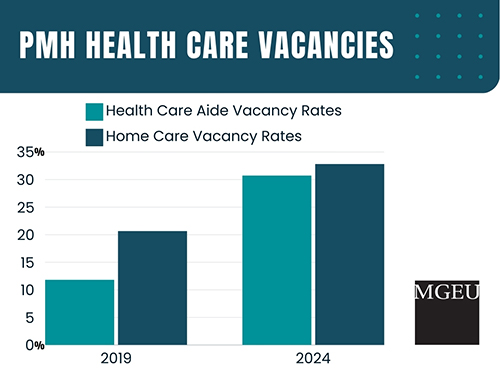Health care aide vacancy rates in PMH tripled over five years, while private agency costs at IERHA more than doubled in two years
The MGEU says new data that shows vacancy rates in health care continuing to climb, and health regions spending millions more on private agencies, are clear indicators of just how significant the province’s health care staffing crisis has become.
Through a Freedom of Information and Protection of Privacy Act (FIPPA) request, the MGEU has obtained numbers that show vacant health care aide positions in Prairie Mountain Health have more than tripled over the past five years – from 154 (11.84% vacancy rate) in 2019 to 489 (30.74% vacancy rate) in 2024.
 Meanwhile, the number of vacancies in that region’s Home Care Program have also jumped – with 157 vacant positions (32.85% vacancy rate) recorded in 2024, compared to 109 (20.68% vacancy rate) in 2019.
Meanwhile, the number of vacancies in that region’s Home Care Program have also jumped – with 157 vacant positions (32.85% vacancy rate) recorded in 2024, compared to 109 (20.68% vacancy rate) in 2019.
“That’s a lot of people, that’s a lot of jobs that urgently need to be filled, and it shows just how big the short-staffing problem is for these workers right now,” said MGEU President Kyle Ross.
While vacancy rates in the Interlake-Eastern Regional Health Authority are lower for home care (9.4% vacancy rate) and health care aides (9.3% vacancy rate), the amount that region is spending on private agencies has ballooned. For the 2023/24 fiscal year, the IERHA spent $8.75 million on private agencies, more than doubling the amount it spent on agency costs in 2021/22.
PMH is also currently on pace to exceed last year’s numbers, with almost $15 million (including $6.9 million for travel costs) already spent on private agencies in the first nine months of this fiscal year.
Ross calls the regions’ increasing reliance on private agencies providing health care a poor use of taxpayer dollars.
“If you look at the significant travel costs associated with going to an agency, it’s millions of dollars that could be better spent on wages and recruitment initiatives that improve those jobs and make the public-sector more attractive for these workers.”
He says that improving wages, benefits, and working conditions would go a long way in helping health regions to fill these vacancies.
“The short-staffing we’re seeing in the public system and the growing spending on private agencies are clear signs of just how deep the staffing crisis has grown. The only way out is to hire more people, and the only way to do that is to make the jobs more competitive in the market so that people are choosing this work over other jobs.”

